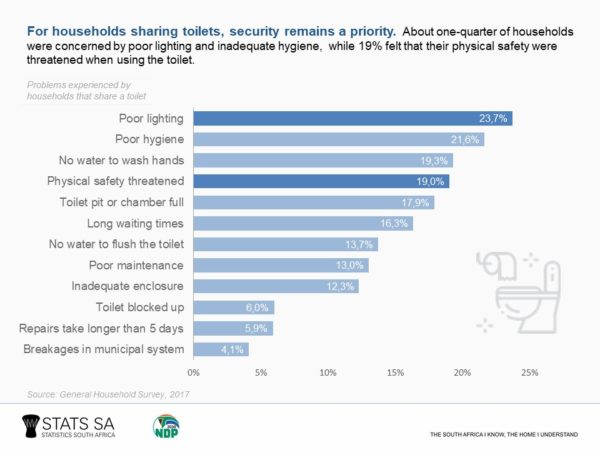More than 60% of the world’s total population either have no access to a toilet within their home, or no access to a toilet that safely manages waste. In 2017, 17.8% of South Africans did not have access to toilets with adequate sanitation.
In 2002, 38.3% of the country’s populace did not have access to toilets.
By comparison, 93.6% of South Africans own cellphones – this means more people have cellphones than access to bathrooms.
To commemorate World Toilet Day on 19 November, there was a focus on improving access to toilets and ensuring the availability and sustainable management of water and sanitation for everyone in South Africa by 2030.
“Despite the improved access to sanitation facilities, many households continue to be without any proper sanitation facilities,” StatsSA said.
Access to proper sanitation is a human right, and ties in with the human right to dignity. “Toilets must also provide for the requirements of women and girls using public and community toilets. Shared toilets allow households who do not have toilets in their individual homes access to toilets. However, they do present a myriad of problems which point to health and safety issues in communities,” StatsSA said.

According to 2017’s General Household Survey, 23.7% of households without toilets are concerned with poor lighting in shared bathrooms, while 21.6% are concerned about the poor maintenance and unsanitary conditions. “Going to the toilet is a basic human need. Women and girls are more at risk of attack and if the toilet facilities are poorly lit they cannot go to the toilet when they want or need to,” StatsSA said. “Shared toilets or community toilets do not address the needs of women and girls who are at greater risk of harassment and sexual violence than men. Shared toilets are usually poorly maintained, ultimately posing risk for illnesses such as cholera and diarrhea.”
Although washing one’s hands after using the toilet is necessary to help prevent illness, 17.9% of households complain that they have no access to clean running water. “Lack of basic sanitation indirectly inhibits the learning abilities of millions of school-aged children who are infested with intestinal worms transmitted through inadequate sanitation facilities and poor hygiene. Every year, millions of the world’s poorest people die from preventable diseases caused by inadequate water supply and sanitation services. Women and children are the main victims,” StatsSA said.
Other complaints recorded included long waiting times (19,3%), threats to physical safety (16,3%) and improper or inadequate enclosure of toilets (12,3%).
Picture: Pixabay

